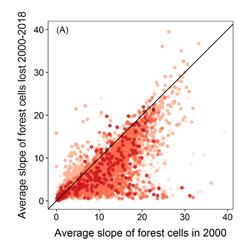Supervisor
David Edwards
Brief Summary
The preferential clearance of flatter and lowland tropical forests means that remaining habitat tends to be on steeper slopes (see Figure). What are the implications of this trend for biodiversity and carbon stocking? On the one hand, species requiring flatter areas may be lost and carbon sequestration rates and stocking potential may be less on steep slopes, but on the other hand, steeper areas may offer climate connectivity and refugia, and better protection from hunting and degradation. This project will use field data, global range maps, and remotely sensed carbon and land-use change products to quantify the conservation risks and benefits of steeper tropical forests.
Importance of Research
Tropical forests of the Anthropocene will be smaller, simpler, steeper, and emptier than they are today. While the implications of diminished size and connectivity, reduced structural and community complexity, and extirpation of overexploited species are well quantified, understanding the potential risks and benefits of forests being increasingly restricted to steeper, less-accessible areas is a key question. Tropical forests are less frequently cleared at high elevations and on steep slopes – likely due to the difficulty of farming, logging, or building on these areas – resulting in remaining forests that, on average, are steeper across all four tropical continents. The consequences for biodiversity and for ecosystem functioning and services of losing disproportionate amounts of forest on level terrain have not been well studied. Species that require flatter areas in lowlands, montane valleys, and mountain tops are likely to be acutely vulnerable to future deforestation, potentially driving biotic homogenisation, yet research quantifying the number of such specialists is lacking. In turn, the relative ability of sloping versus flat forests to sequester and store carbon is a major knowledge gap. A combination of field data, global range maps, and remotely sensed carbon and land-use change products are needed to resolve these critical issues.
Project Summary
Clearance of flatter areas means that remaining tropical forests are on average steeper. This PhD project will quantify the biodiversity and carbon consequences of increasingly steep tropical forests. It will use a combination of field data sources and global range maps to project species at risk from clearance of flatter areas and consider the capacity of remaining steeper areas to better facilitate species movements and survival as they track optimal climatic niches under climate change. It will then use carbon maps and habitat deforestation, degradation, and restoration products to quantify potential consequences for carbon sequestration and stocking.
What will the successful applicant do?
- Bring together evidence of species habitat use from published accounts and databases, potentially including citizen science records (eBird, iNaturalist, etc)
- Map and quantify the pan-tropical consequences of steeper tropical forests for species range area and diversity.
- Use climate change projections to quantify connectedness of flatter and steeper areas to analogous climates
- Use remotely sensed carbon and habitat-change products to understand the impacts of steeper forests for carbon stocking, plus sequestration under restoration.
References
Edwards DP, Socolar SJ, Mills SC, Burivalova Z, Koh LP, Wilcove DW (2019) Conservation of tropical forests in the Anthropocene. Current Biology 29: R1008-1020
Senior RA, Hill JK, Edwards DP (2019) Global loss of climate connectivity in tropical forests. Nature Climate Change 9: 623-626

